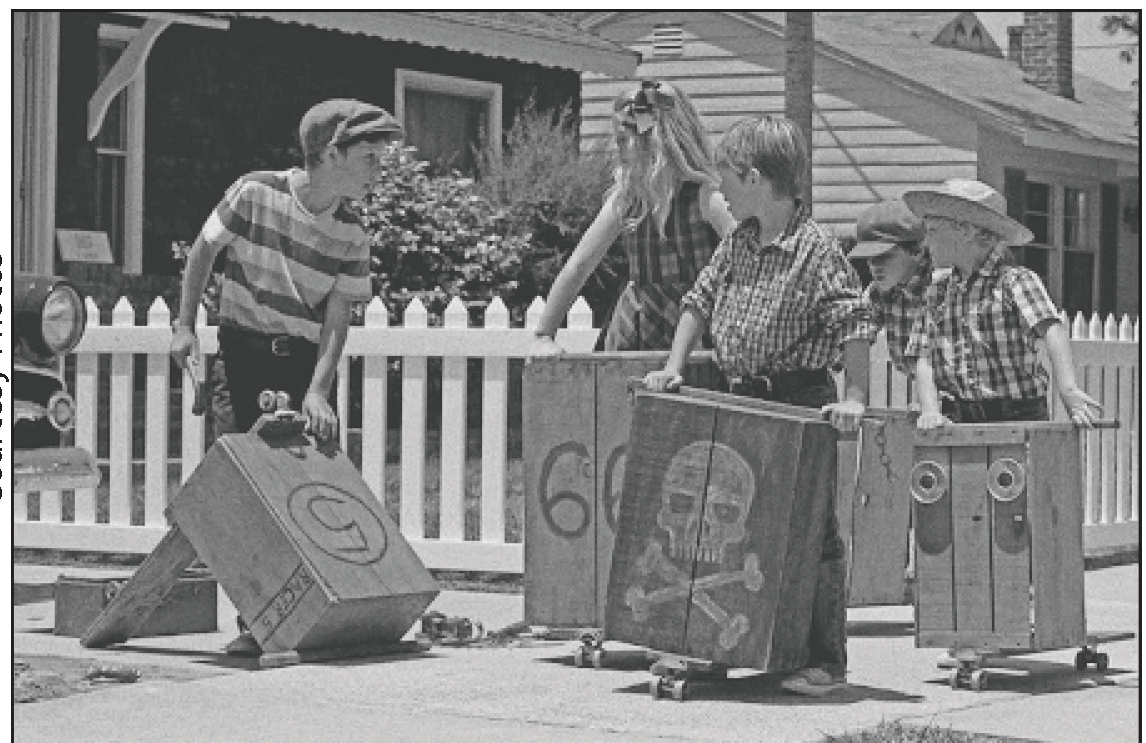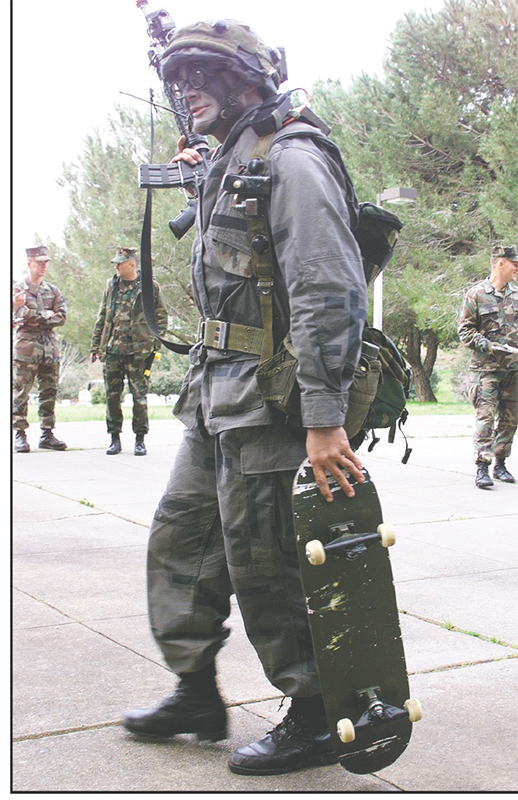Part One
Terry Pryor
With the official opening of the Thurmont Skate Park in November, it might be interesting to understand a little more about this fascinating sport. Skateboarding is a sport that discriminates against no age group. That being said, you should assess your level of fitness and stability.
Skateboarding is usually safe for children aged six and above with adult supervision and the correct skateboard protection, such as helmets, and knee and elbow pads. Similarly, skateboarding is not just for kids. Adult skateboards are extremely popular, with many adults building their own as opposed to buying.
As with any extreme sport, you’re bound to fall and get a few scrapes along the way, and skateboarding is no different. Knee and elbow pads help absorb heavy impact and allow you to slide out of tricks, hardshell pads doing the former and gaskets, the latter. Both knee and elbow pads come in various sizes. Oversized pads are great for riders who will be riding lots of big quarter pipes or even half pipes, whereas smaller pads, tucked under the jeans, tend to be the preference of the street rider. (Bear in mind that this will cause you to rip through your new jeans at some point.) Gaskets are the more comfortable option, allowing you to slide out of tricks, particularly on the street, but hardshell pads will always be better for taking hard impact, reducing permanent damage to those elbow and knee joints.
Skateboards haven’t been around for long. Interestingly, it appears that Crate scooters (1940s era) preceded skateboards. A wooden crate was attached to the nose (front of the board), which formed rudimentary handlebars. With rollerskate wheels attached to the bottom, the boxes turned into planks, similar to the skateboard decks of today.
Skateboarding, as we know it, was probably also born sometime in the late 1940s, or early 1950s, when surfers in California wanted something to do when the waves were flat. No one knows who made the first board; it seems that several people came up with similar ideas around the same time, but the first manufactured skateboards were ordered by a Los Angeles California surf shop. The shop owner, Bill Richard, made a deal with the Chicago Roller Skate Company to produce sets of skate wheels, which they attached to square wooden boards. Accordingly, skateboarding was originally denoted “sidewalk surfing,” and early skaters emulated surfing-style maneuvers and performed barefoot.
By the 1960s, a small number of surfing manufacturers in Southern California, such as Jack’s, Kips’, Hobie, Bing’s, and Makaha, started building skateboards that resembled small surfboards and assembled teams to promote their products. One of the earliest skateboard exhibitions was sponsored by Makaha’s founder, Larry Stevenson, in 1963 and held at the Pier Avenue Junior High School in Hermosa Beach, California. Some of these same teams of skateboarders were also featured on a television show called Surf’s Up in 1964, hosted by Stan Richards, which helped promote skateboarding as something new and fun to do.
As the popularity of skateboarding began expanding, the first skateboarding magazine, The Quarterly Skateboarder was published in 1964. The magazine only lasted four issues but resumed publication as Skateboarder in 1975.
The first broadcast of an actual skateboarding competition was the 1965 National Skateboarding Championships, which were held in Anaheim, California, and aired on ABC’s Wide World of Sports. Because skateboarding was a new sport during this time, there were only two original disciplines during competitions: flatland freestyle and slalom downhill racing.
One of the earliest sponsored skateboarders, Patti McGee, was paid by Hobie and Vita Pak to travel around the country to do skateboarding exhibitions and to demonstrate skateboarding safety tips. McGee made the cover of Life magazine in 1965 and was featured on several popular television programs: The Mike Douglas Show, What’s My Line, and The Tonight Show Starring Johnny Carson, which helped make skateboarding even more popular at the time.
The growth of the sport during this period can also be seen in sales figures for Makaha, which quoted $4 million worth of board sales between 1963 and 1965. By 1966, a variety of sources began to claim that skateboarding was dangerous, resulting in shops being reluctant to sell them and parents being reluctant to buy them. In 1966, sales had dropped significantly and Skateboarder Magazine had stopped publication. The popularity of skateboarding dropped and remained low until the early 1970s.
In the early 1970s, Frank Nasworthy started to develop a skateboard wheel made of polyurethane, calling his company Cadillac Wheels. Prior to this new material, skateboards wheels were metal or “clay” wheels. The improvement in traction and performance was so immense that from the wheel’s release in 1972, the popularity of skateboarding started to rise rapidly again, causing companies to invest more in product development. Nasworthy commissioned artist Jim Evans to do a series of paintings promoting Cadillac Wheels; they were featured as ads and posters in the resurrected Skateboarder Magazine, and proved immensely popular in promoting the new style of skateboarding.
In the early 1970s, skateparks had not been invented yet, so skateboarders would flock and skateboard in such urban places as the Escondido reservoir in San Diego, California. Skateboarder magazine would publish the location and skateboarders made up nicknames for each location such as the Tea Bowl, the Fruit Bowl, Bellagio, the Rabbit Hole, Bird Bath, the Egg Bowl, Upland Pool and the Sewer Slide. Some of the development concepts in the terrain of skateparks were actually taken from the Escondido reservoir. Many companies started to manufacture trucks (axles) specially designed for skateboarding. As the equipment became more maneuverable, the decks started to get wider, reaching widths of 10 inches and over, thus giving the skateboarder even more control.
In 1975, skateboarding had risen back in popularity enough to have one of the largest skateboarding competitions since the 1960s: the Del Mar National Championships, which is said to have had up to 500 competitors. The competition lasted two days and was sponsored by Bahne Skateboards and Cadillac Wheels. While the main event was won by freestyle spinning skate legend Russ Howell, a local skate team from Santa Monica, California, the Zephyr team, ushered in a new era of surfer-style skateboarding during the competition that would have a lasting impact on skateboarding’s history. The team of 12 became known as the Z-Boys and would go on to become one of the most influential teams in the sports history.
Soon, skateboarding contests for cash and prizes, using a professional tier system, began to be held throughout California, such as the California Free Former World Professional Skateboard Championships, which featured freestyle and slalom competitions.
In March 1976, Skateboard City skatepark in Port Orange, Florida, and Carlsbad Skatepark in San Diego County, California, would be the first two large-size US skateparks to be opened to the public, just a week apart. They were the first of some 200 skateparks that would be built through 1982.
The 1980s period was fueled by skateboard companies that were run by skateboarders. The focus was initially on vert ramp skateboarding. The invention of the no-hands aerial (later known as the ollie) by Alan Gelfand, in Florida in 1976, and the almost parallel development of the grabbed aerial by George Orton and Tony Alva in California, made it possible for skaters to perform airs on vertical ramps. While this wave of skateboarding was sparked by commercialized vert ramp skating, a majority of people who skateboarded during this period did not ride vert ramps. As most people could not afford to build vert ramps, or did not have access to nearby ramps, street skating increased in popularity.
Freestyle skating remained healthy throughout this period, with pioneers inventing many of the basic tricks that would become the foundation of modern street skating, such as the “Impossible” and the “Kickflip.” Since few skateparks were available to skaters at this time, street skating pushed skaters to seek out shopping centers and public and private property as their “spot” to skate. (Public opposition, in which businesses, governments, and property owners have banned skateboarding on properties under their jurisdiction or ownership, would progressively intensify over the following decades.) By 1992, only a small fraction of skateboarders continuing to take part in a highly technical version of street skating, combined with the decline of vert skating, produced a sport that lacked the mainstream appeal to attract new skaters.
During this period, numerous skateboarders—as well as companies in the industry—paid tribute to the scenes of Marty McFly skateboarding in the film Back to the Future for its influence in this regard. Many pros started skating because they saw that film.
In the early 1970s, Frank Nasworthy started to develop a skateboard wheel made of polyurethane, calling his company Cadillac Wheels.

Skatecrate’s rolled skateboard history forward.

Soldier carrying a skateboard during a military exercise in Oakland, CA (March 1999).
some of the most common skateboarding terms, expressions, and meanings
180: a half skateboard and body rotation, performed either frontside or backside
360: a complete skateboard and body rotation, performed either frontside or backside
ABD: acronym for “Already Been Done”
Acid Drop: to skate off the end of an object without touching the board with your hands and without ollieing
Airwalk: an aerial trick in which the skater grabs the nose of the board, kicks the feet out while in the air, and then quickly back on when he’s about to land it
Backside: a trick or turn executed with the skater’s back facing the ramp coping or the obstacle
Bail: to jump or step off the board safely when a move goes wrong
Brain Bucket: a helmet
Carve: a maneuver in which the skater makes a long, curving arc
Complete: a skateboard with all its components: deck, trucks, wheels, bearings, and grip tape
Deck: the wooden area of your skateboard that you stand on
Fakie: to ride your skateboard backward
Five-O (5-O): a type of grind
Goofy-Foot: a skater that rides with his or her right foot forward
Hanger: the largest part of the truck that is mostly exposed to grinding
Indy Grab: a trick in which the skater grabs the board mid-air with the back hand
Mob: to have bad style
Ollie: a trick in which the skater uses his or her feet to pull the skateboard up into the air
Pop Shove-It: a trick that combines the ollie with shove-it and enables the board to get to the air and rotate along its vertical axis

